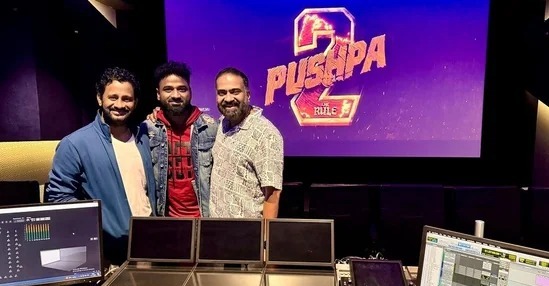With the much-anticipated sequel to Pushpa: The Rise—Pushpa 2: The Rule—ready to hit the big screens, excitement is at an all-time high among fans and the film industry alike. Directed by Sukumar and starring Allu Arjun in the titular role, the first Pushpa movie created waves upon its release in 2021, becoming a cultural phenomenon. Its unique storytelling, vibrant characters, and action-packed sequences, combined with memorable music, led the film to become a massive success. Now, with the sequel poised to make an even bigger impact, there is one critical element that sound designer and Academy Award-winning sound engineer Resul Pookutty wants theatres to pay special attention to: the calibration of their sound systems. In a recent statement, Pookutty, who has been brought on board for Pushpa 2, urged cinema theatres to adjust their sound systems—specifically the speakers—“well in time” before the film’s release to ensure the audience experiences the movie as intended by the filmmakers. His comments have caught the attention of both cinema owners and moviegoers, raising an important discussion about the significance of sound in the cinematic experience, and how it can affect the audience’s overall enjoyment of a film. In an age where immersive sound design plays a crucial role in the storytelling of big-budget films, Pookutty’s advice serves as a timely reminder that movie watching is not just about what we see, but also about what we hear. To understand why Pookutty’s advice is so crucial, it’s important to first appreciate the role that sound design plays in modern filmmaking. In the world of cinema, sound is often considered as important as visuals, if not more so. It enhances the narrative, elevates emotions, and creates an atmosphere that transports the audience into the world of the film. This is particularly true for films like Pushpa 2, which are designed to be larger-than-life experiences with gripping action, dramatic music, and immersive soundscapes. Sound designers like Resul Pookutty have become essential to the process of filmmaking, helping to ensure that the film’s auditory elements align perfectly with the visual ones. Pookutty, who won an Academy Award for his work on the film Slumdog Millionaire, has a reputation for creating cutting-edge sound designs that push the boundaries of what is possible in a cinema environment. His work is known for its attention to detail, with every sound effect, dialogue, and piece of music meticulously crafted to enhance the audience’s emotional connection to the story. In action films like Pushpa 2, sound plays a particularly critical role. The film features intense action sequences, emotional beats, and high-octane drama, all of which rely heavily on sound to create impact. From the rumbling of explosions to the crackling of intense gunfire, and the heart-pounding background score by Devi Sri Prasad, the sound is integral to creating an immersive experience. Without proper calibration of the sound system in theatres, audiences may miss out on key audio details, diminishing the overall cinematic experience. In a traditional cinema setting, one of the biggest challenges is the acoustic quality of the theater. While most modern theatres are equipped with surround sound systems that are designed to provide an immersive experience, there are many factors that can impact the clarity and balance of sound. This can include issues like poor speaker placement, the acoustic properties of the space, or technical malfunctions that result in subpar audio. Even the most expensive and well-engineered sound systems can be rendered ineffective if not set up properly. When it comes to big-budget blockbusters like Pushpa 2, sound becomes even more critical, as these films rely on an elevated sensory experience to captivate their audiences. For example, the bass-heavy beats of a mass number or the tension-filled silence before a pivotal action scene need to be felt by the audience—not just heard. If a speaker is not calibrated correctly, certain frequencies might not be clear, leading to a loss in impact. Moreover, the emotional undertones of dialogues or musical crescendos can be compromised if sound systems are not properly balanced.
This is where Pookutty’s request to cinema owners comes into play. Theatres need to ensure that their sound equipment is optimized for the film. By adjusting the sound system “well in time” for the release of Pushpa 2, cinema owners can guarantee that audiences experience the film as it was meant to be heard. This means ensuring that the sound levels are balanced, that the subwoofer delivers the right amount of bass, and that dialogue is clear and intelligible. Resul Pookutty’s advice holds particular weight because of his vast experience and expertise in the sound design industry. He is not only a highly respected sound designer, but also a technical innovator. His contributions to films like Slumdog Millionaire, Gandhi, My Father, and The Best Exotic Marigold Hotel have earned him a reputation for creating sonic worlds that are immersive and deeply engaging. His role in Pushpa 2 reflects his importance to the film’s production, as he works closely with the filmmakers to bring their vision to life through sound. For Pushpa 2, the expectation is that the film will deliver an even more intense experience than its predecessor. The action sequences are expected to be more elaborate, the emotional arcs deeper, and the music even more striking. Pookutty’s involvement in the project highlights the importance of delivering a top-notch auditory experience, and his call to theatres to ensure their systems are properly calibrated is a reflection of his commitment to the quality of the film’s sound design. Moreover, Pookutty’s comments are indicative of the changing nature of film consumption. While films are still primarily watched in cinemas, an increasing number of audiences are now consuming films on smaller devices—like laptops, smartphones, and televisions. This shift has raised concerns about how the sound experience translates across different viewing platforms. However, the cinema experience remains the gold standard for high-quality sound, and Pookutty’s advice underscores the necessity of maintaining that standard in theatres.

